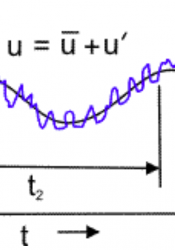Osborne Reynolds proposes Reynolds Decomposition
Osborne Reynolds, a professor of engineering in Manchester and an innovator of fluid mechanics, proposed the concept of Reynolds Decomposition in a correspondence with another pioneer in the field, Sir George Stokes (Jackson, Derek, Launder). The theory proposed that a given fluid stream will be the combination of an expected component and a fluctuation component. The expected component would be found from taking the average of repeatedly conducted experiments, while the fluctuations would be defined as the remaining component that deviates a specific result from the expected component (Adrian).
To some, Reynolds’ theories may have seemed radical and beyond the imagination of 19th-century science. However, like most scientific discoveries, theorems, or laws, the concepts that Reynolds formulated were not entirely his own. Science evolves because innovators combine insights of their forefathers with ideas of their own. In order for Leonardo da Vinci to master linear perspective in The Last Supper, he needed to not only be familiar with the works of those before him, like Leon Battista Alberti’s Della pittura, but also have looked over Piazza San Marco from St. Mark’s Clocktower in order to see the full effects of linear perspective first hand (Heydenreich).
In a similar manner, historians believe that Osborne Reynolds must have been familiar with Leonardo da Vinci’s work on fluid dynamics when he was hypothesizing Reynolds decomposition (Gad-El-Hak). The field of fluid mechanics was in its infancy in Leonardo da Vinci’s era, with few equations available to account for the complexity of fluid motion. However, 400 years before Reynold’s proposed his theory, Leonardo drew an image of a water jet exiting a square hole into a pool. da Vinci wrote that the water appeared to have two separate motions, “one part of which is due to the principal current, the other to random and reverse motion’ (Gad-El-Hak). Leonardo’s breaking down fluid motion into expected and random components was only a qualitative description of the technique that Osborne Reynolds later quantitatively described. But the ideological foundation that da Vinci laid for his predecessors helped solve problems hundreds of years down the road.
Citations:
Adrian, R. J., et al. “Analysis and Interpretation of Instantaneous Turbulent Velocity Fields.” Experiments in Fluids, vol. 29, no. 3, June 2000, pp. 275–290., doi:10.1007/s003489900087.
Gad-El-Hak, Mohamed. “Fluid Mechanics from the Beginning to the Third Millennium.” International Applied Mechanics, vol. 14, no. 3, 1998, pp. 177–185., doi:10.1007/bf02681956.
Heydenreich, Ludwig Heinrich. “Second Florentine Period (1500–08).” Encyclopædia Britannica, Encyclopædia Britannica, Inc., 22 Aug. 2019, www.britannica.com/biography/Leonardo-da-Vinci/Second-Florentine-period-....
Jackson, Derek, and Brian Launder. “Osborne Reynolds and the Publication of His Papers on Turbulent Flow.” Annual Review of Fluid Mechanics, vol. 39, no. 1, 2007, pp. 19–35., doi:10.1146/annurev.fluid.39.050905.110241.
Image:
“Mean Motion and Fluctuations:” NPTEL, nptel.ac.in/content/storage2/courses/112104120/lecture3/3_4.htm.

